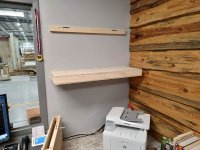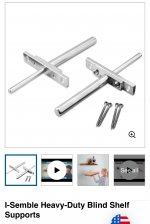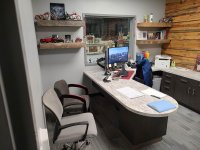Crazyraceguy
Member
- Joined
- Oct 16, 2015
- Messages
- 5,559
There has been some office leap-frog going on for the last few days at work. One person moved into the empty office vacated by the former shop foreman, then it cascaded through 4 others.
As a result, the first one needed some new floating shelves, since the last ones I made stayed in his old office.
The live-edge siding has been on that office wall for a few years, so it was decided to stick with that rough aesthetic. I had quite a bit of that barn wood left over from the last bar I built.
This was somewhat of a surprise project, with no commercial hardware in stock. I came up with this experiment, using the Lamello Zeta Clamex connectors.
The main cleat is 1" thick Poplar, cut to the same width as the 1/2" ply core, with more of that 1" Poplar as the receiving end of the connectors. All of this just clips to the wall and is easily removable. It is very solid, far better than most surface-mounted hardware out there.
The barn wood sleeves just slip right over. If you "attach" them a little more firmly with magnets this design could be used as a stash spot. There is no need for that here. It's pretty much just display space.
As a result, the first one needed some new floating shelves, since the last ones I made stayed in his old office.
The live-edge siding has been on that office wall for a few years, so it was decided to stick with that rough aesthetic. I had quite a bit of that barn wood left over from the last bar I built.
This was somewhat of a surprise project, with no commercial hardware in stock. I came up with this experiment, using the Lamello Zeta Clamex connectors.
The main cleat is 1" thick Poplar, cut to the same width as the 1/2" ply core, with more of that 1" Poplar as the receiving end of the connectors. All of this just clips to the wall and is easily removable. It is very solid, far better than most surface-mounted hardware out there.
The barn wood sleeves just slip right over. If you "attach" them a little more firmly with magnets this design could be used as a stash spot. There is no need for that here. It's pretty much just display space.








